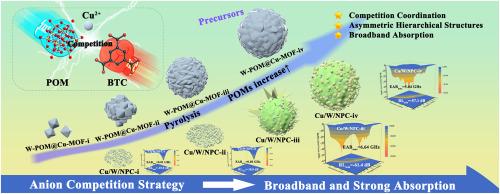Hierarchical structure and compositional engineering in MOF-derived carbon nanocomposites via polyoxometalate-mediated coordination competition for enhanced electromagnetic wave absorption
IF 11.6
2区 材料科学
Q1 CHEMISTRY, PHYSICAL
引用次数: 0
Abstract
Hierarchical structure engineering and multicomponent design are pivotal for developing high-performance electromagnetic wave (EMW) absorbers, however, conventional synthetic strategies still face significant challenges in simultaneously achieving precise control over multi-component, microstructural construction and size regulation. Herein, an asymmetric hierarchical metal–organic framework (MOF)-derived nanoporous carbon (NPC) composite is fabricated via a polyoxometalate (POM)-mediated coordination competition strategy. Tungsten-based POM (W-POM, Na3 [PW12O40]) acts as a dynamic structural modulator during Cu-MOF assembly. By competitively coordinating with Cu(II) ions against organic ligands, the W-POM precisely regulates Cu(II) ion release kinetics and nucleation, enabling concurrent control over precursor size (100–400 nm), morphology (evolving from octahedra to aggregated polyhedra), and composition. Subsequent pyrolysis transforms these W-POM@Cu-MOF precursors into a hierarchical architecture featuring asymmetrically grown Cu nanosheets on porous carbon matrix, alongside embedded Cu nanoparticles and W-POM-derived Na2WO4 heterostructures (Cu/W/NPC). This unique anisotropic configuration synergistically enhances microwave attenuation, where Cu nanosheets and porous matrix prolong propagation paths and induce multi-scattering, while the uniformly dispersed Na2WO4 and heterogeneous interfaces significantly boost interfacial polarization and dipole polarization. Consequently, the optimized nanocomposite exhibits superior EMW absorption performance, achieving a minimum reflection loss (RLmin) of −61.4 dB and a broad effective absorption bandwidth (EAB) of 6.64 GHz. COMSOL simulations quantitatively confirm the abundant interfaces and porous structures synergize polarization dissipation and multi-reflection mechanisms, optimizing impedance matching. Radar cross-section (RCS) simulations further demonstrate significant attenuation (29.84 dB m2), highlighting practical stealth utility. This work establishes a versatile POM-mediated coordination competition paradigm for architecturally and compositionally tailored MOF-derived advanced EMW absorbers.

通过多金属氧酸介导的配位竞争增强电磁波吸收的mof衍生碳纳米复合材料的层次结构和组成工程
分层结构工程和多组分设计是开发高性能电磁波(EMW)吸波器的关键,然而,传统的合成策略在同时实现多组分、微结构结构和尺寸调节的精确控制方面仍然面临重大挑战。本文通过多金属氧酸盐(POM)介导的配位竞争策略制备了一种不对称分层金属有机框架(MOF)衍生的纳米多孔碳(NPC)复合材料。钨基POM (W-POM, Na3 [PW12O40])在Cu-MOF组装过程中起动态结构调制器的作用。通过与Cu(II)离子对有机配体的竞争性配合,W-POM精确调节Cu(II)离子释放动力学和成核,同时控制前驱体尺寸(100 - 400nm)、形态(从八面体进化到聚集多面体)和组成。随后的热解将这些W-POM@Cu-MOF前驱体转化为具有多孔碳基体上不对称生长的Cu纳米片的分层结构,以及嵌入的Cu纳米颗粒和W- pom衍生的Na2WO4异质结构(Cu/W/NPC)。这种独特的各向异性结构协同增强了微波衰减,其中Cu纳米片和多孔基质延长了传播路径并诱导了多次散射,而均匀分散的Na2WO4和非均相界面显著增强了界面极化和偶极子极化。因此,优化后的纳米复合材料具有优异的EMW吸收性能,最小反射损耗(RLmin)为- 61.4 dB,有效吸收带宽(EAB)为6.64 GHz。COMSOL模拟定量证实了丰富的界面和多孔结构协同极化耗散和多反射机制,优化了阻抗匹配。雷达横截面(RCS)模拟进一步证明了显著的衰减(29.84 dB m2),突出了实际的隐身效用。这项工作为mof衍生的先进EMW吸收剂建立了一个多功能的mof介导的协调竞争范式。
本文章由计算机程序翻译,如有差异,请以英文原文为准。
求助全文
约1分钟内获得全文
求助全文
来源期刊

Carbon
工程技术-材料科学:综合
CiteScore
20.80
自引率
7.30%
发文量
0
审稿时长
23 days
期刊介绍:
The journal Carbon is an international multidisciplinary forum for communicating scientific advances in the field of carbon materials. It reports new findings related to the formation, structure, properties, behaviors, and technological applications of carbons. Carbons are a broad class of ordered or disordered solid phases composed primarily of elemental carbon, including but not limited to carbon black, carbon fibers and filaments, carbon nanotubes, diamond and diamond-like carbon, fullerenes, glassy carbon, graphite, graphene, graphene-oxide, porous carbons, pyrolytic carbon, and other sp2 and non-sp2 hybridized carbon systems. Carbon is the companion title to the open access journal Carbon Trends. Relevant application areas for carbon materials include biology and medicine, catalysis, electronic, optoelectronic, spintronic, high-frequency, and photonic devices, energy storage and conversion systems, environmental applications and water treatment, smart materials and systems, and structural and thermal applications.
 求助内容:
求助内容: 应助结果提醒方式:
应助结果提醒方式:


